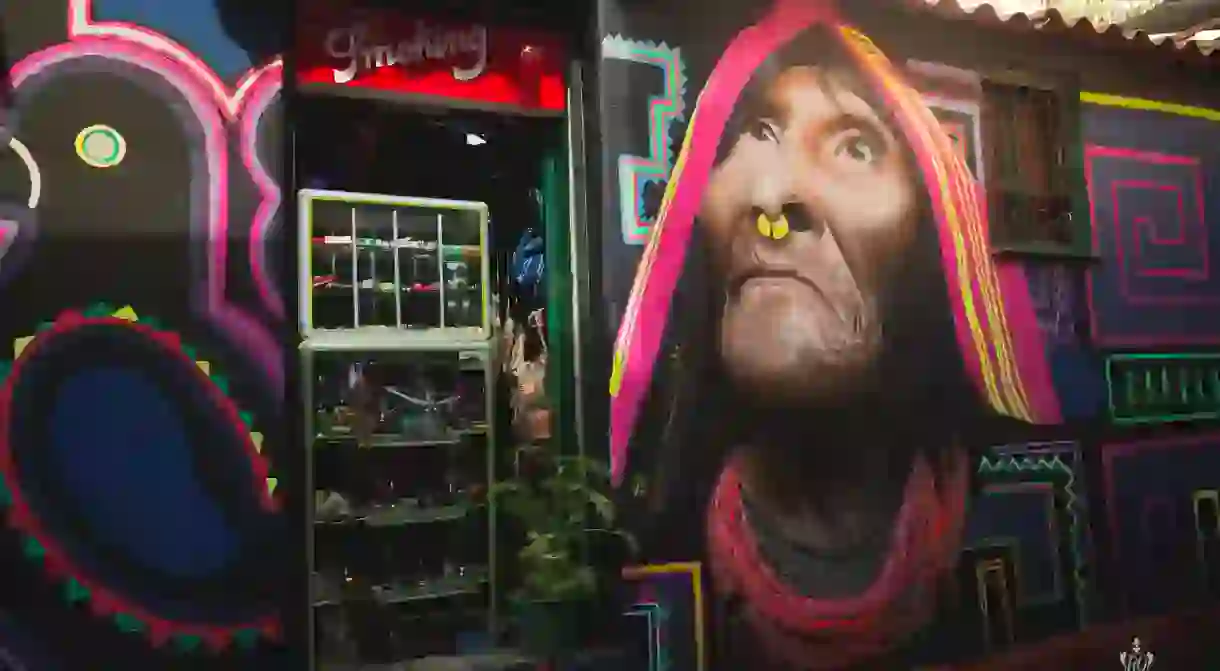Why Is Graffiti Legal in Bogota?

Sometimes from the ashes of tragedy springs the most beautiful art, and Bogota is a shining example. In 2011, after police murdered 16 year-old Diego Felipe Becerra while he tagged his signature Felix the Cat, massive protests erupted throughout the city. This public uproar was partly responsible for the government relenting and ultimately downgrading graffiti from crime to violation to where it is now—condoned. Bogota’s graffiti is more than just beautiful—it reflects the city’s diverse yet tumultuous culture.

Death of Diego Becerra
On August 19, 2011 Becerra was with three of his friends, painting his signature tag under an overpass on Boyacá Avenue, when two police officers found him. One officer chased Becerra and shot him in the back, later claiming that the boy had pulled out a gun and had threatened to shoot.
People cried foul when one of the boy’s friends stated they had only been reprimanded for painting graffiti, which Becerra’s paint covered hands seemed to back up. As the public’s anger and confusion begun to increase, the police backpedalled, stating Becerra was an armed robbery suspect, with the officer later admitting he had altered the crime scene. But the autopsy report’s contradictory information only led to further public outrage, and eventually the United Nations Office for Human Rights condemned the killing.

After massive protests throughout the city, the officer in question was dismissed from the police force, and street art was decriminalized. The mayor’s office went one step further and invited artists to paint buildings that were otherwise “off limits” despite the changed law. They even paid up to $10,000 for murals of figures like legendary writer Gabriel García Marquez.

Graffiti as a regulated art form
Grafiteros and Bogotanos are giving mixed reactions to the government’s permit. Some people who dislike the practice in general complain that nearly every building in Bogota is being vandalized. Graffiti artist DjLu lamented that the mayor giving permission for some places to be decorated while marking others as being off limits is inherently paradoxical when it comes to street art. Graffiti began as an act of defiance, and if artists always abide by the rules, their raison d’être crumbles.
Many embraced the change, seeing it as a way to fix relationships between the city’s establishment and its younger generation—almost like the act of extending an olive branch. Others, like DJLu, think it’s the city’s way of trying to control where graffiti goes up, since the prohibiting it clearly failed. Another ulterior motive could be in the works, as guerrilla advertising campaigns started popping up in the form of street art throughout the city, targeting a large and impressionable demographic.

The benefits of newfound artistic freedom
Grafiteros still find their resolve and graffiti pops up throughout the city on “banned” locations everyday. Instead of being arrested though, now, at most, you’ll receive a fine, if anything. In a lot of ways this has brought the community together. Tagging is no longer seen as a crime—to many people it’s finally become accepted as legitimate artistic expression. CRISP, a graffiti artist in Bogota, says the lack of fear over being jailed or chased over their work allows artists to focus on longer and larger projects that have greater meaning and value for the community.
Bogota’s refreshing approach to street art means that creative minds are finally free to let loose and tell stories about their culture and lifestyle through evocative murals. All this is occurring in a place that is finally winding down a decades-long civil war—an area that can be considered a fertile artistic environment.
There are over 8,000 graffiti artists who call Bogota home, but some of the major players that haven’t already been mentioned in this article include Stinkfish, a local artist whose trademark style incorporates faces from photographs taken around Bogota with intricate designs woven into the boundaries.

Toxicómano, a very popular stencil collective who are represented throughout the city and depict themes that are anti-capitalist and anti-imperialist.

Bastardilla shakes up the traditionally male-dominated graffiti scene with her work that portrays feminism, poverty, violence, pain, and the natural world.

If you want a tour of Bogota’s most beautiful graffiti and to understand the meaning behind individual pieces, check out Bogota Graffiti Tour, one of many tour operators offering you the chance to see the most vibrant parts of the city.













